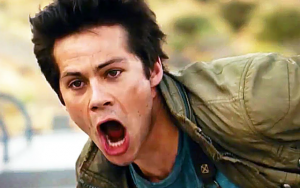Mero In Focus: Maze Runner star’s on-set injury highlights danger of stunts.
 By Richard Crouse – Metro In Focus
By Richard Crouse – Metro In Focus
In March 2016, production was shut down on Maze Runner: The Death Cure when star Dylan O’Brien was hurt filming an elaborate stunt. O’Brien, who rose to fame as the resident heartthrob on Teen Wolf, was strapped in a harness on top of a moving vehicle when he was suddenly thrown and struck by another car. WorkSafeBC reported his injuries included “concussion, facial fracture and lacerations.”
With production postponed, O’Brien’s publicist Jennifer Allen said, “His injuries are very serious and he needs more time to recover.”
Director Wes Ball tweeted, “Well, it’s been a whirlwind of emotions these past few days. I’ve been overwhelmed with feelings of anger and sadness and guilt. But, ultimately I find myself left with just a deep love and respect for Dylan. He is one tough cookie.”
The film, originally scheduled for release on Feb. 17, 2017, was delayed until this weekend.
O’Brien says he was “in a really fragile, vulnerable state,” and during the early days of his recuperation thought he may never act again. “I’ve gotten to a place where I’m OK with it,” he told People, “but it was definitely a rough year.”
The 26-year-old isn’t the first actor to be hurt performing a dangerous deed. Jackie Chan is famous for doing all of his own stunts — and breaking almost every bone in his body in the process — while Mission: Impossible 6 was recently put on hold after Tom Cruise broke his ankle attempting a jump across a building gap.
Sylvester Stallone broke ribs on the First Blood set and Charlize Theron herniated a disc in her spine while shooting Aeon Flux. Jason Statham joked about almost being drowned during the making of The Expendables 3, but it is serious business. How far should filmmakers go in the search for realism in stunts?
Industry insiders say the best way to keep everyone safe is to let the professionals do their jobs. Arnold Schwarzenegger, no stranger to films with wild action scenes, said, “With stunts, we have a rule that if you can get injured or killed, you let a stunt guy do it, because they are much more skilled in how to do the falls, being on fire, how to deal with all those things.”
Stunt driver Richard Lippert asserts that, stunt-wise, actors only have to know how to do three things: first, how to convincingly fake a punch; second, how to drive on and off a mark; and finally, how to credibly handle a weapon. Other than that, he says, “actors shouldn’t plan to do their own stunts no matter how ‘cool’ or exciting it may seem.”
Other than personal danger for the actor, one wrong move can shut down a set costing everyone their livelihoods. “Taking a job away from someone to stroke your ego is not a good way to become popular,” says Lippert.
CGI is another option, although many top directors prefer real action. After years of “following the CG evolution,” using computer-generated images to create beautiful animated films like Happy Feet and Babe: A Pig in the City, director George Miller used actual stunts performed by stunt men and women in his action epic Mad Max: Fury Road. “It was like going back to your old hometown and looking at it anew,” he said.
